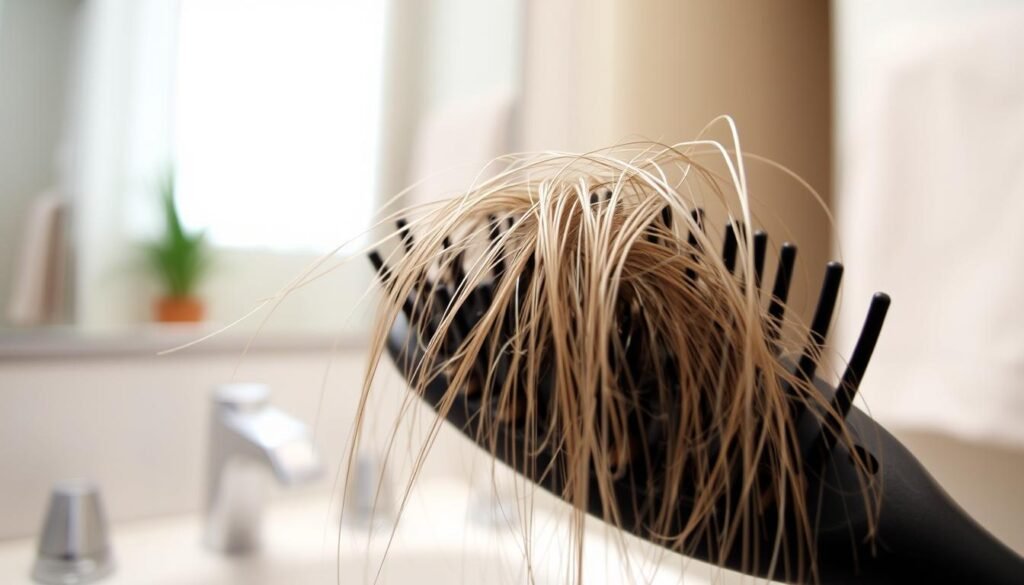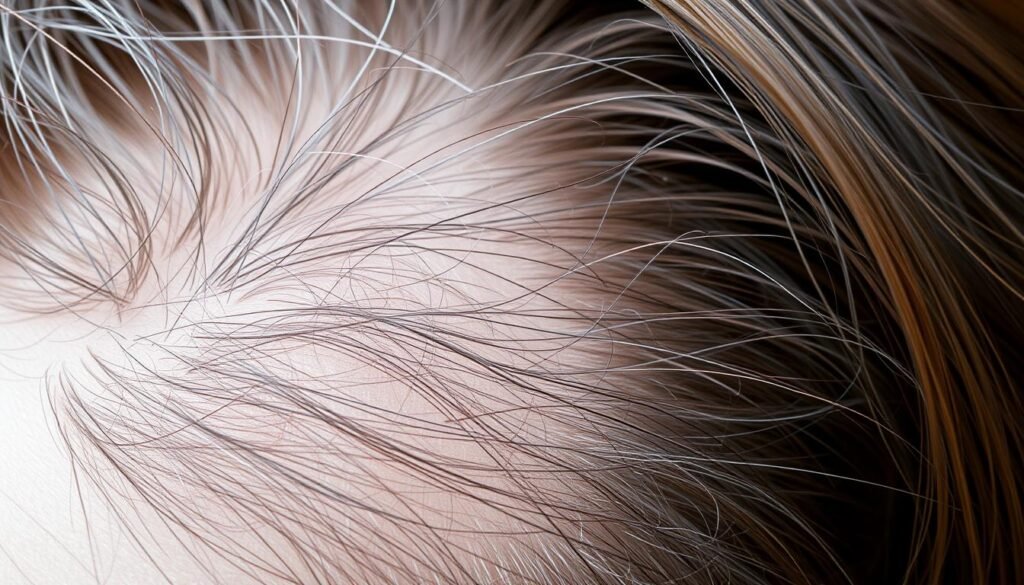Shockingly, about 50 million men and 30 million women in the U.S. face hair loss each year. This often starts in their 20s. Knowing the first signs of hair thinning helps in tackling it early. Hair thinning affects looks and feelings deeply.
Spotting early signs of hair thinning means you can act fast. You’ll learn to see the early warnings before hair loss gets obvious. While losing some hair is normal, too much shedding is a sign to pay attention to. It means you should care more for your scalp and hair.
Key Takeaways
- Hair loss is a widespread issue affecting millions in the U.S. annually.
- Identifying the first signs of hair thinning is essential for early intervention.
- Emotional impact is a significant consequence of hair thinning and loss.
- Excessive hair shedding warrants closer examination and possible action.
- Recognizing subtle changes in hair density can aid in effective prevention strategies.
Understanding Hair Thinning and Loss
Hair loss, known as alopecia, affects both men and women. It can come from genetics, one of the top hair loss causes. Hormone changes, health issues, and aging can also make hair thin.
Stress can lead to hair shedding months after a stressful event. Many notice hair thinning after high stress. An adult’s head usually has 100,000 to 150,000 hairs. Losing up to 100 hairs daily is normal. More than that might mean hair loss is starting.
Male and female hair loss patterns are different. The Hamilton-Norwood scale helps with men’s hair loss, and the Ludwig scale is for women. These scales help find the hair loss stage and plan treatment. Also, alopecia areata is an autoimmune disorder causing patchy hair loss. It affects around 6.8 million people in the U.S.
Diet also plays a role in hair health. Lacking vitamins A, B, C, D, and E, plus iron and zinc, can worsen hair loss. Hair can thin not just because of genes. Bad lifestyle choices and harsh hair treatments can damage hair, making it brittle.
The Early Indicators of Hair Thinning
Spotting the first signs of hair thinning early is key. Often, hair loss starts off quietly, going unnoticed for a while. Many first see a change in their hair’s texture or how thick it feels.
Look out for these clues:
- A widening parting that makes the scalp more visible.
- Thinning spots at the temples or crown.
- A noticeable difference in hair fullness, especially when styling.
Seeing a lot of hair fall out, like over 100 strands a day, is a red flag. This could happen any day or right after washing your hair. It’s a sign that you might need to check what’s wrong.
Knowing these signs is the first step towards finding help. Catching hair loss early can help stop it from getting worse. For more on thinning hair signs, check out this link here.
First Signs of Hair Thinning: What to Look For
Hair loss can be tough, especially for women. It shows up in several signs of balding. A main sign is your hairline changing. If the hair at your temples is pulling back, it’s a hint. Also, if the part in your hair gets wider, it means you’re losing volume.
Keeping an eye on these changes is key. You can take photos over time to really see what’s happening. This way, you catch early signs of thinning. Then, you can do something about it quicker.
There’s more than just the hairline and parting changes. You might find more hair on your pillow or with your hair products. Tracking these bits in a diary helps. It gives you clear points to talk about with a doctor. Knowing these details helps spot trouble early.
Want to know more about hair loss symptoms? Check out this guide for lots of great info.
| Observable Changes | Indicators of Hair Thinning |
|---|---|
| Wider Parting | Increased visibility of scalp |
| Receding Hairline | Altering shape around temples |
| More Hair on Pillows | Excessive shedding during sleep |
| More Hair in Styling Tools | Increased hair loss during grooming |
Recognizing Excessive Hair Shedding
Many people are concerned about excessive hair shedding. Knowing how much hair you lose every day is important. It helps tell normal shedding from signs that need more attention. Identifying these signs is key to finding the right solutions for thinning hair.
Daily Hair Loss Patterns
It’s normal to lose 50 to 100 hairs each day. This number can change because of your hair type and health. Finding hair on your clothes or brush is usual. But, seeing more can mean you’re shedding too much. Dermatologists suggest certain tests if you’re worried:
- Trichometric analysis: A tool that makes your scalp 100 times bigger to look at hair and scalp closely.
- The pull test: Pulling gently on your hair to see if more than six strands come out. This can show different hair loss types.
- The card test: This helps find telogen effluvium and problems with hair strands. It uses a felt card.
Signs During Showering and Styling
Finding more hair in the drain or on the floor can worry you. These signs while showering or styling need attention. As people look for ways to deal with thin hair, knowing the reasons is crucial. Things like hormone changes or not getting enough nutrients can cause hair loss. Blood tests can find low iron levels or hormone issues.

Finding this problem early is important for getting help. Talking to a doctor early can lead to the right tests and treatments. This way, you can keep your hair healthy. For more info on hair problems, check this informative resource.
Common Causes of Hair Thinning
It’s key to know why hair thinning happens to manage it well. Many factors affect this issue. Knowing these factors helps people take steps to improve their hair’s health.
Genetic Factors
Genes greatly impact hair thinning. Androgenetic alopecia, or pattern baldness, is common in the U.S. It causes hair to thin mainly in the 20s or 30s. Hair follicles get smaller, disrupting hair’s natural cycle. So, starting treatments early is crucial.
Hormones also play a big part in hair health. Pregnancy, menopause, and thyroid problems can all cause hair to thin. Stress or illness can lead to losing up to 500 hairs a day. Knowing about these effects helps people find the right treatment. Check out this detailed guide for more information.
Types of Hair Loss and Their Characteristics
It’s crucial to know the different types of hair loss to find the cause and get the right treatment. We will look at male and female pattern baldness, and alopecia areata. Each has unique features and impacts people differently.
Male and Female Pattern Baldness
About 50 million men in the U.S. face male pattern baldness, or androgenetic alopecia. It usually starts with hair receding from the forehead and thinning at the top. Genetics is a major factor; if your family has a history of baldness, you might too.
Female pattern baldness affects roughly 30 million women. The hair normally thins on the part line or the head’s top-central part. Unlike men, women rarely go completely bald. Changes in hormones, like during pregnancy or menopause, often cause hair loss in women.
Alopecia Areata
Alopecia areata leads to patchy hair loss because the immune system attacks hair follicles by mistake. It can happen suddenly to anyone at any age. Often, the hair grows back within a few years. Knowing what triggers the hair loss, like stress or sickness, is key to managing it.
| Type of Hair Loss | Characteristics | Hair Loss Causes |
|---|---|---|
| Male Pattern Baldness | Receding hairline, thinning crown | Genetics, hormonal changes |
| Female Pattern Baldness | Thinning along the part, top-central scalp | Genetics, hormonal changes |
| Alopecia Areata | Patchy hair loss | Autoimmune dysfunction, stress |

Where Hair Thinning Typically Begins
The first signs of hair thinning often show up in certain spots on the head. For men, it usually starts at the front or the top. This can cause a receding hairline or bald patches. Women often see it in the middle of their head. Their hair might look thinner there. Spotting these areas early can help people keep an eye on their hair’s health.
On average, people lose 50 to 100 hairs a day. This loss usually matches the growth of new hair. Hair thinning is closely linked to genetics. Conditions like androgenic alopecia follow a predictable pattern of hair loss. If balding runs in your family, you might see signs of hair thinning sooner.
Getting older also affects your hair. Both men and women may notice their hair thinning as they age. Changes in hormones, like during pregnancy or menopause, can cause hair loss too. Stress, bad eating habits, and certain hairstyles can make it worse. Knowing these signs early is key for anyone noticing the first stages of hair loss.
How to Assess Your Hair Health
Checking your hair’s health is key for spotting early signs of thinning. You can look closely at your hair to see changes in thickness and fullness. Noticing things like more scalp showing or your hairline going back can help you decide what steps to take next. We’ll cover how to tell how healthy your hair is.
Visual Inspection Techniques
Looking at your hair often can show if it’s getting thinner. One way to do this is to check your hair after you wash it or when you’re combing it. If you see more hair falling out than usual, it might mean something’s up. Watch for these signs to better understand what’s happening:
- Look for a receding hairline, a hallmark of male pattern baldness.
- Check for visible scalp that may suggest thinning.
- Identify any random bald spots that could signal hair thinning.
- Monitor hair growth speed; slow-growing hair could indicate problems.
- Take note of comments from others indicating a noticeable change.
Comparative Analysis
Comparing photos over time is a strong way to check on your hair’s health. This lets you see any changes in how thick your hair is and its general look. It’s a good way to test if treatments for thinning hair are working. Plus, advice from hair experts like Dr. Monte Slater or Buckhead Hair Restoration in Atlanta can offer tailored help.
It’s important to spot changes early. This means you can start looking at treatment options that suit you sooner rather than later.

Thinning Hair Remedies and Treatments
Thinning hair? There’s hope with various remedies and treatments. You can find a range of options, from simple to prescription levels. They help promote hair growth and tackle hair thinning. To choose the best approach, talking to a doctor is key.
Over-the-Counter Solutions
Looking for over-the-counter options? Minoxidil, also known as Rogaine, is a popular choice. It boosts hair growth and fights hair loss. Use it regularly, and you might see results in 6 to 12 months. Scalp massages are also great. They can make your hair thicker if you keep at it for six months.
Prescription Options
Prescription treatments offer more ways to deal with thinning hair. Men can use Finasteride, approved by the FDA for male pattern hair loss. It slows down hair loss and encourages growth. Results are often seen after 1 to 2 years of use. Women might consider spironolactone to stop hair loss and aid in hair regrowth. For new treatment methods, platelet-rich plasma injections and light cap therapy have shown promising results in studies.
| Treatment | Type | Expected Results | Usage Duration |
|---|---|---|---|
| Minoxidil | Over-the-counter | Stimulates growth, prevents loss | 6-12 months |
| Finasteride | Prescription | Slows loss, promotes regrowth | 1-2 years |
| Spironolactone | Prescription | Halts loss, encourages growth | Varies |
| Platelet-rich plasma | Prescription | Improves hair thickness | Initial 3 months, then every 3-6 months |
Preventing Thinning Hair
Preventing thinning hair starts with a healthy lifestyle. Proper hair care is also key. Including plenty of proteins, vitamins, and minerals in your diet helps. Regular exercise and managing stress play a role too. Together, they support your overall wellness, which benefits your hair.
Healthy Lifestyle Choices
Adopt these habits for better hair:
- Balanced Diet: Eat foods high in protein like fish, eggs, and beans. Add fruits and vegetables for vitamins.
- Hydration: Drinking enough water daily keeps your hair well hydrated.
- Regular Exercise: Regular workouts boost blood flow, helping nutrients reach your hair roots.
- Stress Management: Try yoga or meditation to lower stress, which can harm hair health.
Proper Hair Care Practices
Follow these tips to avoid hair damage:
- Gentle Styling: Steer clear of tight hairstyles to prevent traction alopecia. Also, limit the use of high heat.
- Quality Products: Choose hair care items that match your hair type. Look for shampoos that help keep moisture and minimize breakage.
- Adequate Rest: Getting enough sleep is crucial for your overall health and hair recovery.
- Regular Trims: Get your hair trimmed regularly to get rid of split ends and keep your hair in good shape.
Conclusion
It’s important to notice the early signs of hair thinning to keep it healthy. This article discussed how genes, hormones, and stress can thin hair. Knowing these can help you look after your hair better.
Today, we have many treatments for thinning hair, from minoxidil you can buy easily to finasteride that needs a doctor’s prescription. Starting these treatments early can really help. Also, if thinning hair is upsetting you, remember there’s a supportive community out there.
Looking after our hair is more than just for looks; it shows how healthy we are. By recognizing the signs early, learning, and taking action, we can handle hair loss positively. This means making good choices for our care and lifestyle.